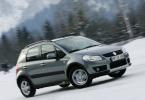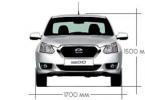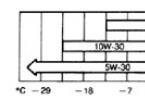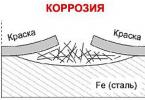From the post-war years to the beginning of the nineties, the owners of domestic cars did not have a headache at all about which wheel to use on their car. There was a Muscovite one with five "holes", a Zaporozhye one with a huge central hole - with four, and a large (as much as 14-inch) Volgovsky one. With five more holes there was a huge, 16-inch Niva disk, but, oddly enough, it was replaced by some amateurs with a Volgov one. Now the variety of wheel disks is such that sometimes you cannot do without a catalog or an all-knowing Internet.
But let's take a look at everything in order: what characteristics when choosing you can play a little and what requirements must be met without fail.
First about the center
Usually, the story about wheel disks begins with the diameter, width and appearance. Although, when choosing a disc, first of all, you need to assess whether it will be possible to screw it to the car.
The most important are the following parameters:
- number of holes for studs or bolts;
- the diameter of the circle on which these holes are located;
- diameter of the center hole in the disc (DIA);
- disk departure.
Now let's take a closer look at these parameters. Immediately, we note that the first two must coincide with those recommended by the manufacturer strictly.
The central hole in diameter can be equal to the native one or be slightly larger. In such cases, sellers usually offer special rings to compensate for the difference in diameters.
The international designation ET is from the German word Einpresstiefe. The shorter the outreach, the greater the vehicle track. The wheel then protrudes from the wheel arch of the vehicle. There are wheels with a negative offset.
Reach is one of the most important wheel indicators that affect the stability and handling of the vehicle. With a reduced overhang, on "wide" spaced wheels, the effort on the steering wheel increases significantly, as well as the load on the hub bearings. A wheel with an extended outreach is displaced into the depth of the wheel arch and can touch the elements of the car during bends or long travels of the suspension, which will lead to damage. When selecting, it is not recommended to deviate from the size of the standard departure by more than 3-5 mm in one direction or the other.
Diameter and width
The rim diameter is usually indicated in inches. It must match the rim diameter of the tire.
The width of the rim is the distance between its rims. Usually it is also indicated in inches, although manufacturers give the width of the tire in millimeters. The current trend is to increase the width of the rims of the wheels and, accordingly, the tires.
These two parameters (diameter and width) people like to tune. Most often, they strive by all means to increase the landing diameter and width of the disc. At the same time, the tire, in order to fit into the wheel arch, becomes low-profile, which warms the soul of many. But at the same time, one should not forget about the GOST to the depth of the pits on our roads - there is such a document! A pit up to 5 cm deep and with a sharp edge has a right to exist. And no one will be punished if you damage your car in it. Now imagine what will happen to low-profile tires in such, even "gostov" pit. For example, with standard wheels of Hyundai cars with a diameter of 15 and 16 inches, the owners manage to put on Solaris… 18-inches! For example, with a 215/35 R18 tire, this solution provides a clearance of only 75 mm between the tire's seating surface and the road. Such a tire, most likely, will suffer (you can pierce the side) even in the "allowed" hole.
However, there is an alternative approach. The bottom line is to try to put discs of the minimum size, only so that they do not cling to the brakes, and the diameter "catch up" with a high-profile one. Among the advantages of this method should be noted the softness of the ride and the lower price of tires of small diameter. For example, the chassis design of the Hyundai Solaris (and the Kia Rio soplatform) allows for 14-inch wheels. And with a 195/70 R14 tire, quite normal wheels are obtained - a little higher (less than 3%) than their relatives, with a dimension of 185/65 R15. But the softness of the move becomes like Renault Logan.
It should be noted that the same options for using discs of different diameters are implemented on crossovers. For example, on the previous generation Nissan X-Trail, you can install 16-inch wheels, which is clearly indicated by the stowaway of this diameter. And from the conveyor, the car went with 17- and then with 18-inch disks. Although there are known cases of the use of wheels up to 20 inches. Here, too, the only question is what you want to get: a car gravitating towards an SUV or a tough "sports barn". The main thing is to know when to stop, because the engine and gearbox are not changed at the same time.
What has changed VAZ?
Now let's talk about how the VAZ betrayed its size. Even on the progenitor, the FIAT-124, the diameter of the circle on which the bolt holes were located, equal to 98 mm, was used. And since then, this size has been strictly observed on all VAZ cars, except for Niva and Oka.
By the way, Italians are also true to traditions. For example, on FIAT Albea, which was officially sold in Russia, it was possible to attach a wheel from a VAZ.
At the same time, the bore diameter gradually increased from 13 to 14 inches over the years and the change of models. But the most recent Grants, Kalinas and Priors still use the 4x98 size.
But with the arrival of the French platform B0, cars with a "round" size 4x100 rolled off the assembly line of the Volga Automobile Plant. These are Largus and XRAY. Vesta can be added to the same list. This is how the VAZ changed its historical size. Cheated with "Frenchwomen" ...
InterchangeabilityFrom the story above, it follows that on a long journey, if there is an urgent need, the owner of Grants, Kalina or Priora may ask to borrow (sell) a spare tire from the owner. And, accordingly, vice versa. If the dimensions of the tires do not match, the wheel can be attached at least to the rear axle by limping to the tire fitting.
The next, perhaps the largest in the world, is the 4x100 club. Small and rather old cars of VW, Opel, as well as Daewoo, Chevrolet had this size. The popular Hyundai Solaris / Kia Rio has the same size. Well, let me remind you that all Logans of the first and second generations, and after them, the latest developments of VAZ also have a size of 4x100. The overhangs of the discs may vary slightly, but almost all fit within the range of 40–52 mm. For example, on a long journey along pretty bumpy roads on a Chevrolet Aveo, I once preferred to ride on disks from the third Golf, which were previously on the SEAT Cordoba. 14 inches versus 15 inches, with the same outer diameter of the tire. Didn't bring hernias!
In the world there is a very wide variety of designs for mounting a wheel disk to the hub. The number of holes on a passenger car can be from 3 to 6. The current trend is to increase the number of wheel bolts or nuts up to five, even on small passenger cars. For example, on VW Polo, besides the fact that five bolts are used, the thread also has the following characteristics: M14x1.5. This, by the way, is the size of the bolt threads of much more massive Mercedes sedans and crossovers. On the other hand, four bolts with modest parameters M12x1.25 on a rather massive Citroen C4 somehow make you tense when a tire changer with a powerful wrench comes to the car. I would not have ripped off the thread - there have been cases ...On a long road
In principle, if you have a spare wheel, or at least on trips near your place of residence, you don't have to bother about the interchangeability of wheel disks. But I can advise, before a long journey, to figure out which discs from which common cars can fit yours. What if it comes in handy?
PCD
It will take no more than a few minutes to find the required position.
How to use the catalog of wheel rims by car make?
The site has an online tool for quick selection of products of interest. Wheel parameters by car make will be found after you specify step by step:
- The model of car;
- year of its release;
- design differences or modification features.
Further, the system will automatically display information about the standard sizes of disks by car brand. You will be able to see not only the factory configuration, but also see suitable replacement options (if any). Thanks to this, even a person who is poorly familiar with the features of the machine will be able to purchase a suitable kit.
In any case, before purchasing, read the information about the dimensions of the wheels by car model specified in the instructions for service and operation. If in doubt, consult with the specialists of the online store site or with the employees of the official dealer representative. Remember that deviations are unacceptable and will lead to either inability to use the purchased product or to problems with driving safety.
You can pick up alloy wheels for the car online, purchase orders are also accepted by contact phone numbers.
Lending terms:
- Loan term: 2–36 months
- Credit limit: from 10,000 rubles. up to 300,000 rubles
- Interest rate - determined by the bank based on your data and credit history
How to place an order on credit?
To place an order on credit, just follow a few simple steps:- Decide on the product and place an order on the website or through a call-center operator
- After placing the order, the bank manager will contact you, advise on the terms of the loan and agree with you to meet to sign the contract
- Meet at a convenient time for you with a bank representative and sign the agreement
- After signing the contract, you need to wait for the bank to pay us your order. Money transfer takes 2 to 3 business days. As soon as the money is received from the bank, we will send you an SMS with an offer to pick up the order
- Come to our center with a passport and a loan agreement to receive an order
Loan conditions
- Russian citizenship with permanent registration
- Age from 18 years
- Purchase amount from 10,000 to 300,000 rubles
- Required documents: passport of the Russian Federation, SNILS
When replacing disks and tires, taking into account the geometric data obtained from tire calculator, it will not be superfluous to make several measurements yourself. First, the distance from the suspension to the inner surface of the wheel, and also from the shock absorber cup to the tread surface. Secondly, from the wing, as well as the steering rods to the tread surface. At the same time, the geometric parameters of the new wheel assembly should not greatly exceed the size of standard tires and disks. Otherwise, unstable behavior of the vehicle may occur.
A few basic rules to remember when changing tires and wheels.
- The tread of summer tires has a standard depth of 0.8-1 cm;
- When installing discs with a larger diameter than the standard ones, it is necessary to reduce the overhang value - for every inch of height 3 mm overhang;
- It is not uncommon for the hub bores on discs that are not original to have a larger diameter. Therefore, when installing them, you need to use special rings for fixing;
- In the event that the hole on the disc is smaller than the hub mounts, it is strictly forbidden to drill them out, as well as grind the hub itself;
- The correct selection of non-original wheels using a calculator will allow you to preserve the driving characteristics of the car;
- If you are not sure about the compatibility of tires or wheels with your car, it is better not to install, or contact specialists for help.
1. What needs to be done?
Choose the right rims for the existing car, along the way, having dealt with all the necessary parameters.
2. What parameters of the disk should be considered when purchasing?
Regardless of what kind of car you have, when choosing new wheels, you need to consider the following parameters:
- disk type;
- mounting (or landing) diameter;
- the number and diameter of the location of the mounting holes (PCD);
- disk width;
- disk departure (ET);
- diameter of the central (hub) hole;
- the shape of the mounting holes;
- the presence of humps.
Let's make a reservation right away: if by this moment you have no longer the desire to deal with all these parameters, when choosing disks, simply use the selection service for a car in large online stores. There, you can simply indicate the model of your car and get discs that are guaranteed to fit it in all respects. Well, if the determination to find out everything is still with you, then let's get down to it.
3. Disk type - what they are
All discs are generally divided into three types according to the type of manufacture: stamped, cast and forged. The issue of choosing a specific type is a topic for a separate material, but here we will highlight the main differences.
Stamped discs- the cheapest: these are the same wheels that you see on the basic trim levels of budget cars, and they are usually covered with plastic decorative caps. They are made of steel and painted with enamel. Among their advantages, in addition to the lowest price, is high maintainability. The fact is that stamped discs do not break when struck, but crumple, and later they can be easily repaired. The main disadvantage of such wheels is their high weight and lack of design: this is a purely functional product.
Alloy wheels compete with the stamped ones in popularity. Such discs are made not of steel, but of a lighter alloy - usually aluminum. Thanks to the manufacturing technology, alloy wheels can have a wide variety of shapes, which, together with a lower weight than that of "stamps", makes them popular. Among the disadvantages of such wheels, we can mention the higher price and lower maintainability: alloy wheels do not crumple under a strong impact, but crack. Of course, the technology of welding repair and rolling has long been mastered, but it is impossible to guarantee the preservation of the original properties after repair.
Forged wheels- the highest quality and most expensive option. They are made by hot die forging, which provides the best internal metal structure and, accordingly, the highest strength at the lowest weight. The downside of this method is the low prevalence of products and the high price.
In addition to the above three types, there are also so-called prefabricated discs - but this is already exotic, and we will not touch on them. In general, for the average car owner, the choice is between inexpensive but boring stamped wheels and more expensive and beautiful alloy wheels.
4. Mounting (landing) diameter
This is an obvious parameter: the diameter of the disc's circumference in inches. Typically, it is designated by the letter R: that is, the R 17 disc is 17 inches in diameter.
Note especially: the letter R itself does not refer to the diameter and came from the parameters of the tires, where it is also mistakenly used in the meaning of "radius", in reality it means the rim diameter of the tire. In the case of the R tire, this is the marking of the radial structure of the cord, but for the disc, this marking is actually not relevant. However, the erroneous "radius" in the meaning of "diameter" and the accompanying R are so ingrained in speech that most vendors and services for selecting disks are already used by default.
The permissible rim diameters for your car are indicated in the owner's manuals and on stickers in the doorways - along with the recommended tire pressures. When buying tires, it is worth remembering that their rim diameter must match the diameter of the rims.

It is not recommended to exceed the maximum diameter specified by the manufacturer: too large discs, in addition to potential geometric incompatibility, change the parameters of the suspension, affecting the wear of the chassis. In addition, the larger the disc and the lower the rubber profile, the less comfort promises to travel on bad roads. However, changes in diameter within the limits specified in the manual, and even an inch in excess, usually go without significant consequences.
5. The number and diameter of the location of the mounting holes (PCD)
This is the so-called "bolt pattern": the number of holes and the diameter of the circle on which they are located (by the way, the English PCD is just the diameter of the circle, "Pitch Circle Diameter"). The number of fixing bolts can be different and increases with increasing mass and speed of the car: usually there are 4-6 of them, but there can be more or less (minimum 3). Most VAZ cars have a bolt pattern of 4x98, with the exception of Oka (3x98) and Niva (5x139.7), as well as new models like Largus (4x100).
The looseness of the disc must be observed: although some discs - for example, 4x98 and 4x100 - seem to be interchangeable, this is not the case. The seemingly insignificant 2 millimeter difference in the diameter of the circle on which the mounting holes lie will greatly affect the installation: only one of the four mounts will be correctly tightened, and the rest will be offset from the center, causing the wheel to run out. Part of the problem can be solved by using bolts with a "floating cone" (about them below), but in general, the use of discs with inappropriate bolt pattern should be avoided.
6. Width of the disc
This parameter is as simple as diameter: it is the width of the disc in inches. It is usually denoted by the letter J in the parameter list: for example, 5.5J is a disc with a width of five and a half inches.
The width of the disc is usually indicated in the same places as the permissible rim, along with it. In addition to the geometric parameters for a car, the width of the rim is also important when choosing tires: the tire is designed to be used with a rim of a certain width, but with some allowable error.
7. Departure of the disk
The overhang of the disk is the distance from the mating plane of the disk to the hub to the longitudinal axis of symmetry of the disk. Let's put it more simply: the central axis of symmetry is the line dividing the disc in half along the above-described width, and the mating plane is the point where the disc touches the hub and is screwed to it.
The offset can be positive, zero and negative: if the axis of symmetry lies closer to the car than the mating plane, then the offset is positive, if they are on the same axis, then the offset is zero, and if the axis of symmetry is more distant from the car than the mating plane, then the offset is positive. ... In other words, the larger the offset, the deeper the disc sits in the wheel arch, and the smaller it is, the more the disc protrudes outward.
Departure is a rather important parameter: it also directly affects the operation of the suspension and wheel bearings. Incorrect overhang not only increases or decreases the track, but can also cause accelerated wear of the chassis and bearings.
8. Diameter of the central (hub) hole
The diameter of the center hole is a parameter that does not need additional explanation. It is usually referred to as "Dia", "DIA" or "D" in the disc specification sheet. This is also an extremely important indicator: if the central hole of the disc is less than required, the disc simply cannot be installed, and if it is larger, then centering rings will be required to center the disc on the hub.
Many people mistakenly believe that when installed, a disc with a too large center hole will center itself on the hub by tightening the bolts, but this is not the case. Accordingly, runout and vibration that do not disappear after wheel balancing is a reason to check the coincidence of the diameters of the central hole of the disc and the hub and the presence of centering rings, if necessary.
9. Shape of mounting holes
The shape of the mounting holes is important in terms of the type of bolts or nuts that will hold the disc. As a rule, bolts and nuts for stamped discs have only a slightly tapered plane that adjoins the disc when tightened, and the bolts are also noticeably shorter.
The latter is related to the minimum thickness of the stamped disc. The cast disc is noticeably thicker than the stamped one, and in addition, its mounting hole has a more pronounced conical shape, which requires the use of other fasteners. In addition to the tapered one, the seat of the mounting hole of some discs can be designed for the use of fasteners with a hemispherical and flat working part.

And one more thing: there are bolts with the so-called "floating cone": they allow to partially compensate for a slight discrepancy between the PCD disc and the required parameters. The working conical part of such bolts is made in the form of a separate ring put on the bolt, and is displaced relative to the longitudinal axis of the bolt when tightened.
10. Hump availability
Hump Are the protrusions on the outer surface of the rim that secure the tubeless tire to the rim. Remember the pops that are heard when a tire is inflated after being installed on a rim? This is the moment of "landing" of the tire: the bead ring of the tire sits between the hump and the rim of the disc. In fact, this indicator is indicated last in our material, because at the present time it is practically irrelevant: almost all modern wheels are designed for the installation of tubeless tires and have humps.
However, if, for example, you decide to purchase old-fashioned retro wheels, keep in mind that they may well be designed for the installation of exclusively tube tires, without having humps. On them, however, you can install tubeless tires, but the issue of its tight fit, as well as safety while driving, will remain open: with insufficient tire pressure, the risk of "taking off your shoes" in a turn will be very high.



